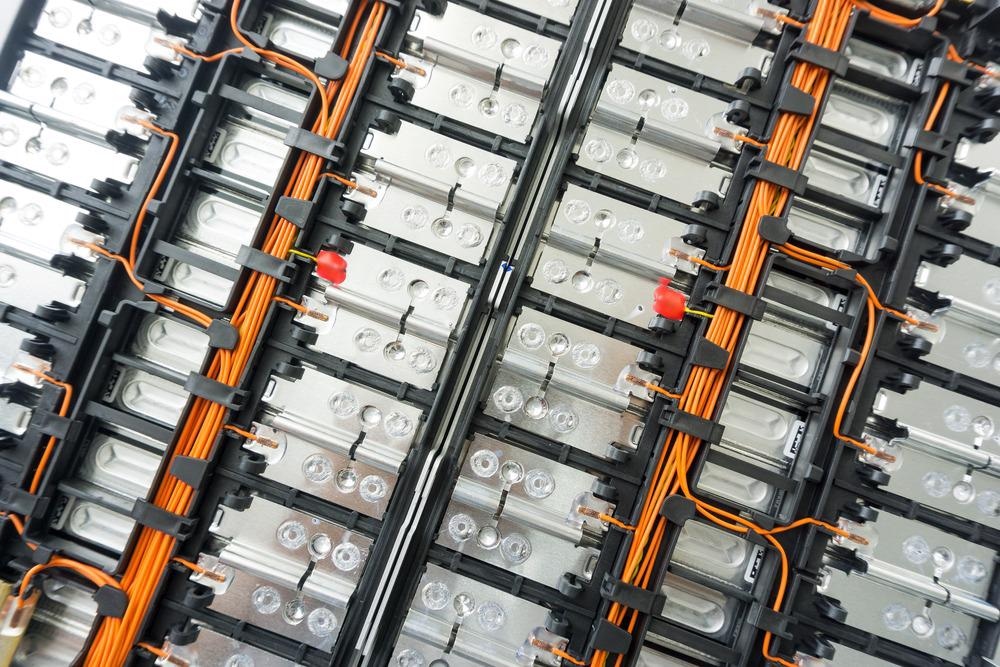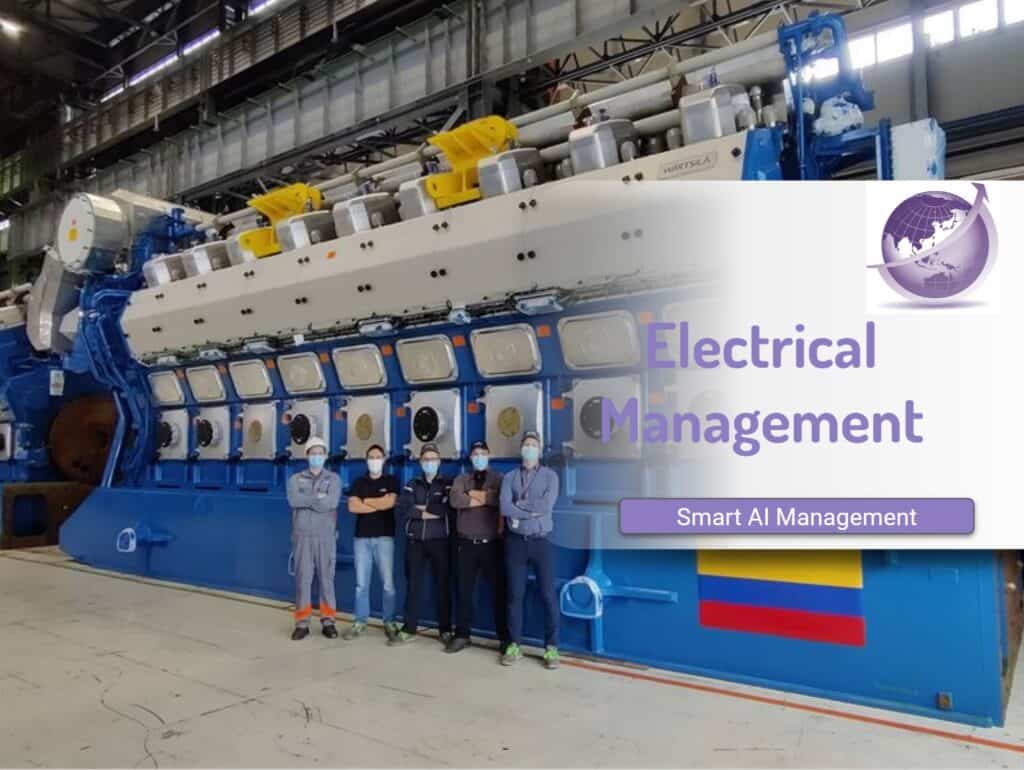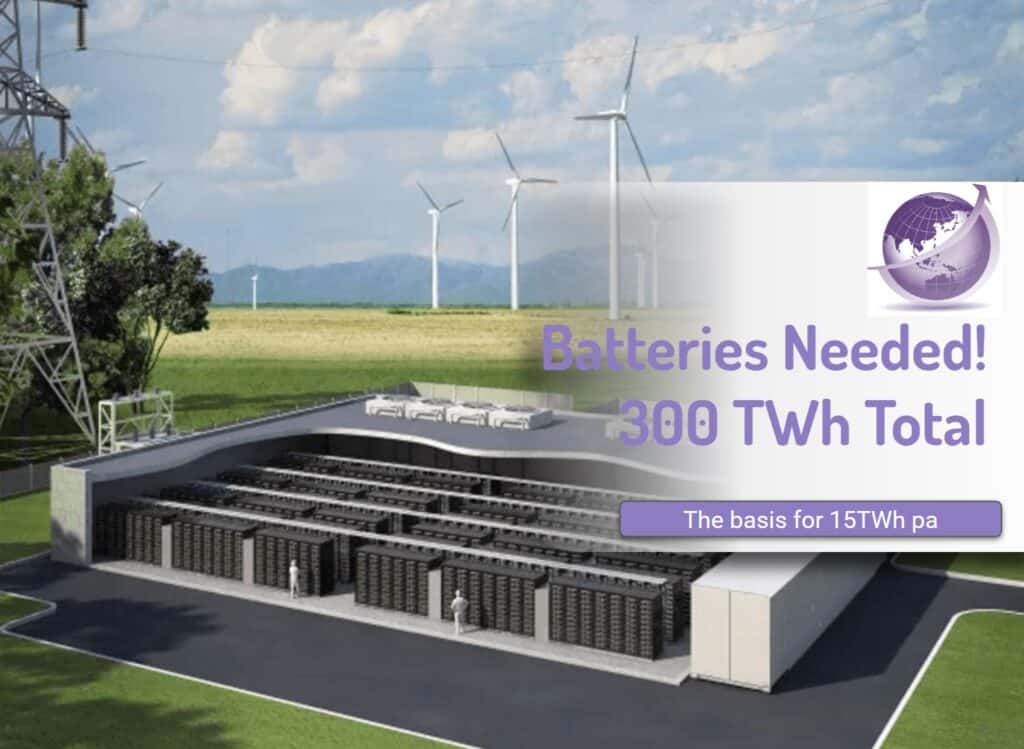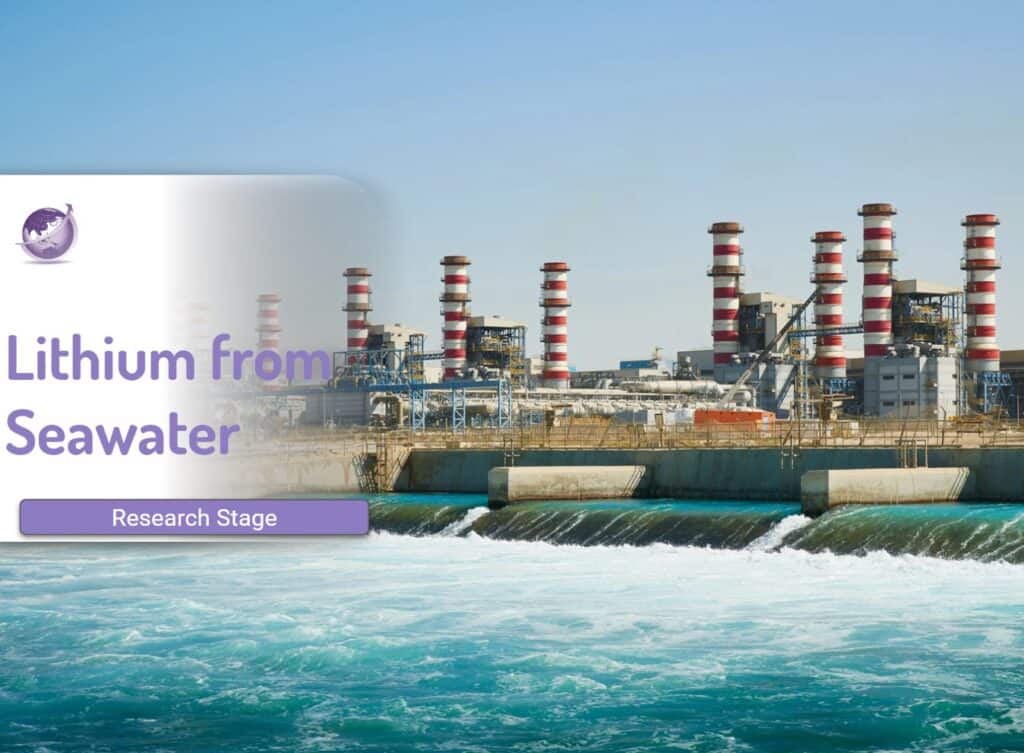With R&D in full swing to develop new battery technologies, there are numerous press releases about the latest lithium battery improvements using modifications or alternate chemistry and improved manufacturing systems. As well as improvements there are improvements in redox flow batteries and with alternatives to chemical storage. What 7 critical improvements will new battery technologies affect?
- Battery density Wh/kg
- Weight – a function of density
- Recharge cycles over lifetime
- Lifetime
- Speed of charging and discharge
- Mechanical size, shape and stability
- Price
Density Key to New Applications
Battery density is important for transport – planes, trains and automobiles. It is not for stationary storage.
- Lithium Ion (nickel based) 250 Wh/kg
- Lithium ion phosphate (LFP) 180 Wh/kg
- Nickel Cadmium (NiCad) 50-70 Wh/kg
- Nickel Metal Hydride: 60-120 Wh/kg
- Lead acid: 35-40 Wh/kg
- Vanadium flow 10-20 Wh/kg
- Alkaline: 100 Wh/kg (poor recharging)
- Lithium – sulphur 1,300 Wh/kg (R&D)
- Lithium air: 500Wh/kg (R&D)
- Sulphite Solid State 350Wh/kg (R&D)
- Human fat cell: 37,000 Wh/kg or 250-760Wh/L. 10% efficient. (Why losing weight by exercising is almost impossible!)
- Jet fuel: 12,000Wh/kg. 40% efficient and depends on turbo props vs jet and speed.
- Petrol: 10,000 Wh/kg, 20% efficient into motion.
- Coal: 10,000 Wh/kg (33% efficient to electricity)
- Hydro: depends on height and flow. see DoTheMaths
- Uranium: 19 million Wh/kg (76 million J/kg)
Chemistry Or Type
- Flow Batteries – vanadium, iron, ZnBr, Salt, HBr (article)
- Lead acid
- Pumped Hydro (article)
- Gravity and pressure (article)
- Ocean Pumped Hydro (article)
- Liquid Metal Batteries (article)
Many times new battery technologies are about changing the composition of the anode (usually graphite) or cathode technologies (lithium). Rare earth elements (ready more) maybe incorporated as well.
Large Decline in Costs (97%) since 1991. Forecast to Continue
OurWorldinData shows battery costs have decreased 97% by 1991 and forecasts are for a further 90% decline within a decade.

A full list of about 70 is found on Wikipedia, and a review paper by Mauler et Battery cost forecasting: a review of methods and results with an outlook to 2050† DOI: 10.1039/D1EE01530C has also detailed forecasts and identified 53 studies that provide time- or technology-specific estimates for lithium-ion, solid-state, lithium–sulfur and lithium–air batteries among more than 2000 publications! Further, 360 extracted data points were consolidated into a pack cost trajectory that reaches a level of about 70 $ (kW h)−1 in 2050, and 12 technology-specific forecast ranges that indicate cost potentials below 90 $ (kW h)−1 for advanced lithium-ion and 70 $ (kW h)−1 for lithium-metal based batteries. These indicated battery costs will halve within this decade, which is conservative against prior costs.
Grid-Scale Batteries
There are not many grid-scale batteries around the globe, although there are many battery manufacturers. But the grid-scale batteries have 2 components.
- Modular battery – that can be scaled
- Control system that manages the charging and discharge, frequency etc.
Solid State Batteries
In the hunt for new batteries, solid state batteries are a contender. The largest battery manufacturer, CATL warns
The first generation of solid-state batteries, which have roughly the same energy as current lithium-ion batteries, is expected to emerge by 2025, with their market share approaching 1% by 2030, CATL said. It added that second generation solid-state batteries with new cathode and anode materials are expected to emerge after 2030, and the next generation of solid-state batteries is expected to enter the market after 2035.
CATL via GreenTechnica Jan 2022
Solid state batteries replace the gel material between the anode and cathode with a solid material. The challenge is that lithium can grow “dendrites” from the cathode out, and eventually cause a short, then fire. Studies include non-ceramic solid-state electrolyte based on a graphene oxide (GO) aerogel framework filled with polyethylene oxide. Read more at AZO Nano.
SVolt has now produced a prototype batch of 20 Ah cells with a solid electrolyte based on sulphide. SVOLT also delivers the first promising numbers. The prototype solid-state cells have an energy density of 350-400 Wh/kg. This is in line with SVOLT’s earlier tests, and the result promises a range of over 1,000 kilometres for electric cars in future.
Solid State Batteries from Nio
Toyota has been beaten to market already by a demonstration by the CEO of the Chinese manufacturer Nio. Nio model ET7 car drove 1,044 km taking 14 hours with an average consumption of 132 Wh/km at an average speed of 84 km/hr. It was not ideal conditions, with the temperature at departure at -2oC. The 360 Wh/kg is supplied by Beijing WeLion New Energy Technology.
Organic Polymer
Polyjoule has announced research (10,000 battery scale) that use electrodes made of conductive polymers. Simply put, a conductive polymer is an organic-based compound that is not a metal, but can act like one. At the core of a conductive polymer chain, alternating carbon-to-carbon single and double bonds connect to form a conductive backbone that allows electrons to flow along the polymer chain.
- Uses traditional methods of construction i.e. standard roll-to-roll processing in non-cleanroom environments,
- Alternating anodes and cathodes interwoven and connected in parallel to form a cell.
- 6 times faster discharge than LIOn
- Recharge in under 5 minutes
- No heating or cooling required
- 12,000 recharge cycles
- 100% discharge
- No lithium required
Potassium Ion
Austin-based potassium-ion battery startup Group1 says its technology has comparable energy density to lithium iron phosphate (LFP), and that it is aiming for a large-scale launch of its product by 2027. their material’s capacity is 156mAh/g. This could be in production from 2030.
Manufacturers of Systems
This list can be added to as suppliers enter the market. For the top 50 in the USA, check out this site. In Australia the main players are:
- Tesla – use Megapacks which are normally based on the 2170 batteries
- Doosan – from Korea. Unclear which batteries but their software is at Doosan Energ
ABB has a good dataset of new battery technologies (Full Report Here)
There are other startup companies and University based research announcements. From lab to production is costly in time and money.
New Battery Technology Announced
| Company | Details | Battery Type | Links/ Notes |
|---|---|---|---|
| Solid Power | Investment, from Ford, BMW, Hyundai, Daimler, Samsung | Solid State | |
| Quantum Scape | $300m investment from VW. Claims a battery that can charge to 80% in 15 mins. | Solid State | |
| BlueSolutions | Investment from Daimler | Solid State | |
| Innolith | Energy density of 1000 Wh/kg, | Lithium-ion | |
| Ionic Materials | $65m investment from Renault-Nissan Mitsubishi | Solid State | |
| Libtec consortium | Honda, Nissan, Toyota, Panasonic | Solid State | |
| ProLogium | Enovate | Solid State | |
| SVOLT (ex Great Wall) | solid electrolyte based on sulphide. First promising numbers of prototype solid-state cells with energy density of 350-400 Wh/kg. | Solid State | Electrive Review Sept 2022 |
| AMTE Power | Silicon anode | ||
| Enovix | Silicon anode | ||
| Enevate | Silicon anode | ||
| Hibar Systems | Acquired by Tesla | Lithium-ion | |
| Sila Nanotechnology | Silicon anode | ||
| OXIS Energy | Lithium-S | ||
| Métalectrique Research & Development (MAL) | LG Chem, Sanyo, Johnson Matthey, the UK MoD (DSTL) and Southampton University | Aluminium Air | |
| Maxwell Technologies | Acquired by Tesla, Maxwell is a specialist in ultra-capacitors and Tesla is interested in its dry electrode / solid state batteries | Lithium-ion, Solid State | |
| NanoGraf | Graphene anode manufacturer | Lithium-ion | |
| Kreisel Electric | Collaboration with Shell | Lithium-ion | |
| QuantumScape | Recently listed on the stock exchange and partnering with VW | Solid state | |
| Dyson | Dyson continues with investment in solid state technology despite abandoning its EV car project. | Solid state | |
| SES | Solid state | ||
| StoreDot | Collaboration with EVE Energy. Daimler, BP, Samsung and TDK have invested | Silicon anode | |
| Foxconn | Limited production by 2024 | Solid state | |
| Toyota | Limited production by 2024 | Solid state | |
| 1414 Degrees | SiBox 1MW based thermal energy 1414 degrees is molten Si | Silicon Heat | 1414 Degrees |
| Swiss Clean Battery (SCB) | Protected electrolyte with anode from solid lithium metal conductor (not graphite). Scaling from 1.2 GWh to 7.6 GWH by 2023 | Solid state | Swiss Clean Battery AG High Performance Battery is designer |
| PolyJule | Organic polymer. Research phase, 10,000 cycle | Polymer | Polyjoule Lithium free battery |
| Iron flow | iron electrolyte, 4-12 hours duration, 25 year life | Iron flo | ESS Iron Flow Long Term Storage |
| Group1 (startup) | Claim K-ion battery can charge faster and has better low-temperature performance because K+ moves faster than Li+ | potassium ion cathode | Science paper PV Magazine Article |
| Avanti Energy | For house storage. Battery kept at 100 degrees plus. Up to low kWh phase. At prototype stage, no energy density number | Aluminum, sulphur salt | Avanti Energy MIT Announcement |
Battery Technology Announcements
There are so many announcements of improvements it can be confusing. The route from research to production is very slow and only some of the technology makes it to the end. Announcements tend to be either about energy density, longevity, charging speed or changing chemistry.
- At Japan Advanced Institute of Science and Technology (JAIST), researchers have developed an approach to anode fabrication that could lead to extremely fast-charging lithium-ion batteries. The group used poly (benzimidazole), a bio-based polymer that can be synthesized from raw materials of biological origin as the precursor material for the anode. They achieved very fast charging (XFC) 18.6 A g−1 and had minimal degradation over 3000 cycles (Mining.com) with over 90% charge retention.
- In Nature researchers showed at at 1,300kW/kg lithium-sulphur batteries may be practical after all: 4000 cycles with negligible degradation, 650mAh/g energy density, which is something around 6x higher than the best lithium-ion battery.
Speed of Charging
- Charging times are a hugely important factor when it comes to driving the adoption of electric vehicles
- US startup Enovix has a 3D Lithium silicon generation battery design, which it says can now be nearly completely recharged in less than 10 minutes.
- Silicon anodes can theoretically store more than twice as much lithium than the graphite anode that is used in nearly all Li-ion batteries today (1800mAh/cm3 vs. 800mAh/cm3). Enovix say they have fixed 4 problems with LiSi Anodes. See more at their site. They claim 1,000 cycles while retaining 93% of its capacity.
- First Charge Expansion
- First Charge Efficiency
- Cycle Swelling
- Cycle life
Energy Density and Volumentric Density Relationship
Energy density, cost, recharge time, lifetime are all important depending on intended application. Airplane, EV or grid storage need to be dense.
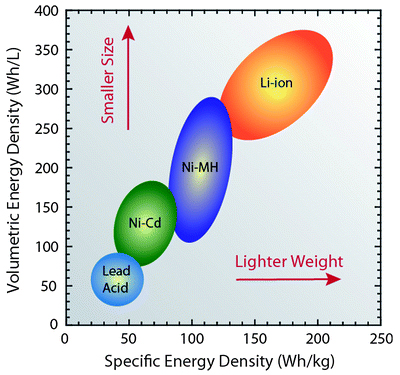
Warning: Much hype. (See AFR) The potential for Energy Vault’s gravity-based, building block storage technology has attracted some of the world’s biggest participants in the decarbonisation journey – Saudi Aramco, BHP and now Korea Zinc. A potential $US32 billion ($44.6 billion) of projects using the technology could be deployed over the next five-10 years, the Switzerland-based company says.
Solid State Batteries And Companies

New Lithium-Ion Technologies
All the while these new technologies are moving from research lab to production, lithium ion batteries are improving
Stockhead Reports on that researchers from the University of Queensland have developed a nanotechnology that more than doubles the lifespan of high-voltage Li-ion batteries. Professor Lianzhou Wang and his team from the School of Chemical Engineering and Australian Institute for Bioengineering and Nanotechnology have designed a unique atomic-thin layer on the surface of a high-voltage cathode, which is the source of lithium ions and a critical aspect that limits the cycle life in a battery. They’ve demonstrated a battery which remains stable for more than 1000 charge/discharge cycles. They usually only last several hundred cycles.
“Our process will increase the life-span of batteries in many things from smart phones and laptops to power tools and electric vehicles,” Professor Wang said. “Corrosion in one form or another is the reason that batteries degrade over time. “This new approach features a minimal protective coating at a scalable process, paving the way for the deployment of these abundant high-voltage materials for next generation high energy batteries.”
Images of New Battery Technologies
